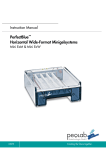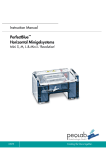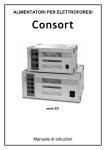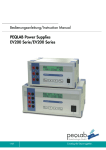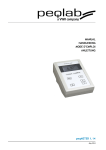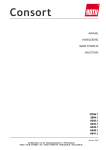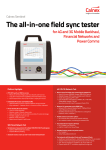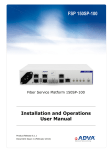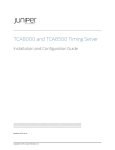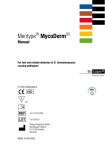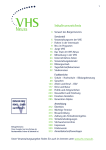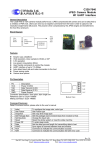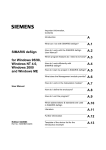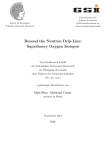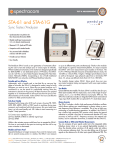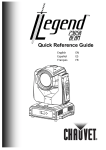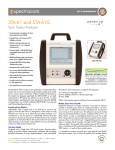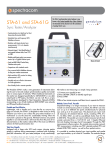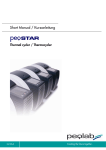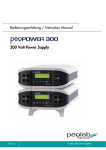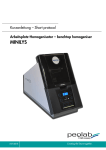Download manual - Isogen Life Science
Transcript
Instruction Manual
PerfectBlue™
Horizontal Maxigelsystems
Maxi S, M, L, ExW, Maxi M 'Revolution' &
Maxi ExW 'Revolution'
PEQLAB Biotechnologie GmbH_v0207E
0507E
Creating the future together.
Instruction Manual PerfectBlue™ Horizontal Maxigelystems
CONTENTS
WARRANTY
1
PACKAGING LIST
1
SAFETY PRECAUTIONS
1
SYSTEM OVERVIEW
2
Technical properties
2
GENERAL INSTRUCTIONS
3
Setting up the system and pouring the agarose gel
Loading of samples and electrophoresis
Visualisation
Cleaning
REQUIRED REAGENTS & RECIPES
Electrophoresis buffers
Agarose: Gel volumes and percentage
Ethidium bromide
Loading buffer/Sample buffer
Molecular weight marker
3
4
4
4
5
5
6
6
7
7
TROUBLESHOOTING
7
TECHNICAL SUPPORT AND ORDERING INFORMATIONS
9
PerfectBlue™ Maxi S
PerfectBlue™ Maxi M & Maxi M 'Revolution'
PerfectBlue™ Maxi L
PerfectBlue™ Maxi ExW & Maxi ExW 'Revolution'
Power Supplies
Agaroses
LITERATURE
PEQLAB Biotechnologie GmbH_v0507E
9
9
10
10
11
11
12
Instruction Manual PerfectBlue™ Horizontal Maxigelystems
WARRANTY
PEQLAB guarantees that the horizontal electrophoresis system you have received has been thoroughly
tested and meets its published specification.
However, immediately upon arrival, please check carefully that the shipment is complete and has not
been damaged in transit. For missing parts or to report any kind of damage, please contact PEQLAB
(see 'TECHNICAL SUPPORT AND ORDERING INFORMATIONS'). Please retain all packaging materials
until the delivery has been completely checked since this will speed up the return of goods if required
and reduce environmental impact. Any form of returns, replacements or credit notes must be agreed in
advance by PEQLAB.
For the complete range of PerfectBlue™ electrophoresis and blotting systems, PEQLAB guarantees a
warranty period of 36 months if the products have been used solely according to the instruction manual
and if not agreed differently. After the warranty period has expired PEQLAB can offer repairs at low
costs. No liability is accepted for loss or damage arising from incorrect use. PEQLAB's liability is limited
to the repair or replacement of the unit or refund of the purchase price, at PEQLAB's discretion. PEQLAB
is not liable for any consequential damages.
PEQLAB reserves the right to alter the technical specifications of the PerfectBlue™ electrophoresis or
blotting systems without prior notice. This will enable us to implement developments as soon as they
arise.
PACKAGING LIST
Unless differently agreed or marked on the delivery note the following items are included in shipment for
the models Maxi S, Maxi M, Maxi M 'Revolution', Maxi L, Maxi ExW and Maxi ExW 'Revolution':
one buffer chamber with corrosion-protected platinum electrodes
one safety lid with attached power cords
one UV-transmissible gel tray and two End Gates
one casting chamber
Maxi S: 3 combs, 1.5 mm thick, 12, 16 and 20 teeth
Maxi M ('Revolution'): 3 combs, 1.5 mm thick, 16, 24 and 36 teeth
Maxi L: 4 combs, 1.5 mm tick, 2 each 25 and 50 teeth
Maxi ExW (including 'Revolution' model): 4 combs, 1.5 mm thick, 2 each 25 and 50 teeth
User Manual
SAFETY PRECAUTIONS
Please, read this Instruction Manual carefully before using the gel system.
Only use a CE marked DC power supply.
Always disconnect the gel system from the power supply before adding electrophoresis buffer.
Always disconnect the gel system from the power supply when it is not in use or before moving it.
Running conditions for this unit should not exceed the maximum operating voltage or current.
Do not fill the chamber with running buffer above the maximum fill line.
PEQLAB Biotechnologie GmbH_v0507E
1
Instruction Manual PerfectBlue™ Horizontal Maxigelystems
SYSTEM OVERVIEW
The horizontal electrophoresis systems PerfectBlue™ Maxi S, Maxi M ('Revolution'), Maxi L and Maxi
ExW ('Revolution') are designed for the separation of medium to high sample numbers at long distances
and provide flat, even banding patterns and consistent results. Their gel trays are getting sealed leak
proof inside the chamber by using End Gates included in delivery. The gasketed End Gates are
specifically engineered to fit accurately into the gel tray grooves eliminating the need to tape or seal the
tray before pouring gels. Utilizing the built-in levelling feature in all of the horizontal Maxigelsystems
allows the user to cast level gels quickly. Four gel sizes are available to provide maximum versatility;
increasing sample capacity and varying sample running length. Depending on the specific model the
UV-transmissible gel trays are equipped with 4 to 12 comb slots so that you can run multiple sample
sets to equal distances simultaneously.
PEQLAB offers a wide variety of standard and microtiter combs in two different thicknesses (1 mm or
1.5 mm). Microtiter combs allow for speedy sample loading using a multichannel pipette. Furthermore
preparative combs for large sample volumes and wall combs to cast gels in smaller sizes are available
for increased versatility. For deviding up the gel tray wall combs are put in the gel tray's slots instead of
a common comb but should get sealed using agarose of higher percentage before casting the gel.
For detailed information on available accessories visit www.peqlab.de or see 'TECHNICAL SUPPORT
AND ORDERING INFORMATIONS'.
The Maxi M 'Revolution' and Maxi ExW
'Revolution' models are equipped with an
internal buffer recirculation system. A trapping
system captures hydrogen bubbles which are
produced at the cathode due to electrolysis, and
directs them through an ascending tube to the
opposing side of the buffer chamber where the
anode is located. During this hydrogen bubble
migration, the buffer circulates, preventing the
creation of detrimental pH or ion gradients.
Schematic drawing: 'Revolution'-Technology
Technical properties
PerfectBlue™
Cat. No.
Gel size (W x L)
Buffer volume
Voltage
Current
Time required
Maxi S
41-1325
13 x 25 cm
1600 ml
20-250 V 0-150 mA
60-120 min
Maxi M
41-2025
20 x 25 cm
2300 ml
20-250 V 0-150 mA
60-240 min
Maxi M 'Revolution'
41-2025R
20 x 25 cm
2000 ml
20-250 V 0-150 mA
60-360 min
Maxi L
41-2340
23 x 40 cm
4500 ml
20-250 V 0-150 mA
60-360 min
Maxi ExW
41-2325
23 x 25 cm
3000 ml
20-250 V 0-150 mA
60-240 min
23 x 25 cm
2800 ml
20-250 V 0-150 mA
60-360 min
Maxi ExW 'Revolution' 41-2325R
PEQLAB Biotechnologie GmbH_v0507E
2
Instruction Manual PerfectBlue™ Horizontal Maxigelystems
GENERAL INSTRUCTIONS
Setting up the system and pouring the agarose gel
1. Remove the lid from the gel box by holding the front of the buffer chamber with one hand and
pulling the lid off by holding the center of the back of the lid. The cover is attached to the back of the
unit at the connection of the power cords to the banana plugs.
2. For convenient storage, the gel tray should be placed inside the unit on the platform with the
gasketed End Gates in position. Lift the casting tray out of the buffer chamber.
3. To cast a gel, place the gel tray into the chamber making sure the gel tray rests level and is centered
on the platform. Slide the gasketed End Gates into the outermost grooves on either side of the gel
tray. The End Gates should be inserted tightly into the grooves with the gasket side facing out.
4. The larger size of the gel makes the need to cast and run a level gel very important for consistent
reproducible results. Level the unit using the thumbscrews on each side of the unit by slowly turning
one thumbscrew at a time and lining up the bubble in the level with the center circle.
5. When preparing the gel use electrophoresis-grade agarose and compatible electrophoresis buffer.
The gel may be prepared in various ways. The percentage of agarose and the buffer used is
determined by the size of the samples to be separated and further recovery of the samples (see
'REQUIRED REAGENTS & RECIPES'). The agarose and buffer are mixed and heated over a heat
plate by stirring or in a microwave oven until the agarose is completely dissolved.
6. The prepared gel then must be cooled to below 60 °C before casting to avoid warping the UVT gel
tray due to excessive heat. If numerous gels are to be run in one day, a large volume of gel may be
prepared and be placed in a covered bottle stored between 40-60 °C in a water bath. This provides
a ready gel supply in a warm liquid form that will solidify quickly when gels are cast.
7. Pour or pipet the measured amount (see 'Agarose: Gel volumes and percentage') of warm agarose
(< 60 °C) onto the UVT gel tray that has been placed into the correct position in the gel box.
Immediately after pouring, insert the desired comb or combs into the comb slots to form the sample
wells. If only a small portion of gel is required for proper sample separation, multiple combs may be
used to run 2, 3, 4, 5 or 10 sets (depending on the model) of samples for equal distances
simultaneously, increasing the number of samples that may be run per gel. To conserve agarose, a
wall comb may also be used to divide and use just half the length of the gel tray. If a wall comb is
used, pipet a bead of agarose along the bottom and side edges of the wall comb once it has been
placed in the tray to seal the combs edges to the trays bottom and sides. Once this bead is solidified
the cooled gel may be poured as described. Alternately, regular tape cut slightly longer then the
comb can be placed flat along the comb’s surface and the comb angled into place in the gel tray.
Extra tape is then placed on the outside of the comb in the excess tray area to reinforce the corners.
NOTE: Allow the gel to solidify completely. Standard agarose should solidify completely in about 30
minutes. If low melting agarose or a speciality agarose is used, please consult the instructions that
came with the product.
PEQLAB Biotechnologie GmbH_v0507E
3
Instruction Manual PerfectBlue™ Horizontal Maxigelystems
Loading of samples and electrophoresis
1. Once the gel is completely solidified, carefully lift the tray out of the chamber as described above
and place it beside the unit.
2. Pour enough compatible running buffer into the unit to fill both compartments and allow it to stand
for about 15 minutes prior to running. Fill the chamber at the cathode end (black electrode) first.
3. Then put the gel tray into the chamber, remove the End Gates and completely cover and submerge
the gel. The running position of the tray exposes the open ends of the agarose to the buffer. A 'Fill
Line' is located on each unit to clearly mark the correct buffer level. Too little buffer may cause the
gel to dry out during the run, while excess buffer may slow DNA migration in the gel and band
distortion.
4. Carefully remove the comb (or combs) by tapping lightly to loosen, and slowly lift straight up out of
the gel tray to avoid damage to the wells.
5. Load prepared samples into the wells. Samples should be mixed with a sample loading buffer, that
gives weight to the samples so that they drop evenly into the wells, and that contains tracking dyes
to monitor the gel run. Refer to 'TECHNICAL SUPPORT AND ORDERING INFORMATIONS' for
approximate well volumes.
NOTE: It is wise to always run a sample lane of a known 'standard ladder' to determine
concentration and size of separated fragments after the gel run, and to aid in photo documentation
and analysis.
6. Carefully slide the lid with attached power cords onto the unit. This will connect the power cords to
the banana plug to complete the circuit. Plug other end of the power cords into an appropriate
power supply.
7. Turn on the power supply and run the gel at the appropriate current (see 'Technical properties').
Carefully monitor the gel run to avoid samples running into the path of another set of samples.
Visualisation
When the gel run is completed and the tracking dye has migrated as far through the gel as desired or to
the end of the gel, turn off the power supply and slide off the lid to disconnect from the power source.
Carefully remove the tray containing the gel (wear gloves if ethidium bromide is present). The UVtransmissible gel tray makes for simple visualisation and photography with a UV light source without the
need to remove the gel from the tray. The gel tray may be placed back into the casting chamber for
convenient transport to the darkroom and to avoid damage to the gel.
Cleaning
The buffer chamber and tray should be rinsed under warm running water after each use. Use a mild
detergent to get rid of any debris. It is recommended to allow the chamber to air dry rather than drying
with a towel to avoid damage to the electrode wires.
Do not use ethanol or other organic solvents to clean acrylic products, because organic solvents cause
acrylic to 'craze' or crack!
PEQLAB Biotechnologie GmbH_v0507E
4
Instruction Manual PerfectBlue™ Horizontal Maxigelystems
REQUIRED REAGENTS & RECIPES
Electrophoresis buffers
In general, electrophoresis buffers supply the ions necessary for electrophoresis and establishing a
certain pH value in which the target molecule adapts to its the required electric charge. Nucleic acids for
example will be negatively charged in an alkaline to neutral surrounding. Additionally, electrophoresis
buffers often contain reagents which protect the target molecule from degradation (e.g. EDTA, which
complexes bivalent cations and therefore inhibits DNases). If electrophoresis under denaturing
conditions is desired (like for the electrophoresis of RNA), electrophoresis buffers will additionally
contain reagents that eliminate the formation of secondary structures.
Below, you will find recipes for TAE and TBE, two of the most commonly used buffers for the
electrophoresis of DNA. If the intention is to eventually isolate DNA from the gel, TAE buffer should be
chosen. In comparison to TBE, migration will be faster and a better resolution of supercoiled DNA will
be achieved when using TAE. However, because of TAE's limited buffering capacity, TBE should be
selected for performing extended electrophoresis separations and if the electrophoresis chamber does
not possess a system for buffer recirculation. PEQLAB's PerfectBlue 'Revolution' Systems are equipped
with such an internal buffer recirculation system which effectively prevents the formation of pH and ion
gradients during extended runs. Since agarose tends to create finer pore sizes and a more solid matrix
in TBE, diffusion of DNA will be reduced and a more discrete band pattern will be achieved.
TAE (Tris-Acetate-EDTA) Buffer
1x working solution:
40 mM Tris-acetate, 1 mM EDTA
50x stock solution (1 l):
242 g Tris-Base
57.1 ml Glacial acetic acid
100 ml 0.5 M EDTA (pH 8.0)
made up to 1 l using H2O
TBE (Tris-Borate-EDTA) Buffer
0.5 x working solution*:
45 mM Tris-Borat, 1 mM EDTA
5x stock solution (1 l)**:
54 g Tris-Base
27.5 g Boric acid
20 ml 0.5 M EDTA (pH 8.0)
made up to 1 l using H2O
* 0.5x TBE is sufficient for agarose gel electrophoresis. For vertical electrophoresis in polyacrylamide gels, 1x TBE
is often applied due to the comparatively smaller buffer reservoirs of vertical electrophoresis chambers.
** 5x TBE stock solutions tend to precipitate during long storage periods and should get remade. Because of this
property, higher concentrations of TBE stock solutions should be avoided.
PEQLAB Biotechnologie GmbH_v0507E
5
Instruction Manual PerfectBlue™ Horizontal Maxigelystems
Agarose: Gel volumes and percentage
PEQLAB offers an extensive range of high quality agaroses, for many specific applications (see
'TECHNICAL SUPPORT AND ORDERING INFORMATIONS').
The required volume of the gel is calculated using the following formula.
gel width (cm) x gel length (cm) x gel thickness (cm) = required volume agarose solution (ml)
The following volumes will result:
PerfectBlue™
Maxi S
Maxi M
Maxi M 'Revolution'
Maxi L
Maxi ExW
Maxi ExW 'Revolution'
Gel size (cm)
13 x 25 (B x L)
20 x 25 (B x L)
20 x 25 (B x L)
23 x 40 (B x L)
23 x 25 (B x L)
23 x 25 (B x L)
Gel thickness (cm)
0.25
0.5
81 ml
162 ml
125 ml
250 ml
125 ml
250 ml
230 ml
460 ml
144 ml
288 ml
144 ml
288 ml
0.75
243 ml
375 ml
375 ml
690 ml
432 ml
432 ml
1.0
325 ml
500 ml
500 ml
920 ml
575 ml
575 ml
The optimal range of DNA fragment sizes separated by any electrophoresis experiment is dependent on
the agarose concentration of the gel. The higher the agarose concentration, the better small fragments
are separated from each other and vice versa. However, for the smallest or largest fragment lengths, the
usage of specialized agaroses or polyacrylamide gels should be considered (see table below), since a
3% agarose solution solidifies rapidly and a 0.3% agarose gel is very soft and difficult to handle.
Agarose content (w/v)
0.3%
0.5%
0.7%
1.0%
1.2%
1.5%
2.0%
3.0%
Agarose (g)
0.3
0.5
0.7
1.0
1.2
1.5
2.0
3.0
Puffer (ml)
100
100
100
100
100
100
100
100
optimal separation range (kb)
5-30
1-15
0.8-10
0.5-7
0.3-6
0.2-4
0.1-3
<0.1
Ethidium bromide
The gel may be stained during or following the run with a variety of stains for photodocumentation. The
most common stain for DNA is ethidium bromide. Because of its capacity to intercalate between the
bases of a nucleic acid strand and altering the sterical properties of DNA, ethidium bromide is judged
to be highly mutagenic. Therefore appropriate safety measures must be applied.
Ethidium bromide may be added directly to the gel before pouring it at a concentration of 0.1 to 0.5
µg/ml. However, being positively charged, ethidium bromide will migrate to the cathode during the
electrophoresis leading to non-homogeneous staining. Improved results can be obtained by incubating
the gel after the electrophoresis is finished in electrophoresis buffer containing 0.5 µg/ml ethidium
bromide for 5 to 20 min. Subsequently the gel should get rinsed in electrophoresis buffer without
ethidium bromide for up to 20 min in order to reduce background signal.
PEQLAB Biotechnologie GmbH_v0507E
6
Instruction Manual PerfectBlue™ Horizontal Maxigelystems
Loading buffer/Sample buffer
Samples are prepared and mixed with loading buffer before applying to the prepared gel. Sample
buffers contain dyes for visibility and glycerol to provide weight to the samples. This increased sample
density ensures samples load evenly into the wells and do not float out during loading. Dyes also
migrate toward the anode end of the electrophoresis chamber at predictable rates allowing the gel run
to be monitored. In 0.5x TBE gels, bromophenol blue migrates at the same rate as 300 bp DNA
fragments and xylene cyanol approximately at the same rate as 4 kbp DNA fragments.
6x DNA sample buffer:
0.25 % (w/v) bromophenol blue
0.25 % (w/v) xylene cyanol FF
30 % (v/v) glycerol
Molecular weight marker
Markers are run on each gel to monitor the quality of sample separation and to enable a size estimation
of specific bands. By running a known marker of a specific concentration in parallel, the DNA amount
of the unknown samples can be estimated. PEQLAB offers an extensive range of DNA and RNA
markers. For detailed information please contact us or visit www.peqlab.de.
TROUBLESHOOTING
Some possible solutions to potential problems are listed below. If these suggestions are unclear or
unsuccessful, please contact PEQLAB.
Problem: Agarose leaks into casting chamber when pouring gel
Check to see if the gasket is firmly seated in the grooves on the ends of the UVT gel tray. Reseat gasket if
necessary by removing and rinsing under warm running water, then reseat evenly in the tray groove.
Problem: Bands seem to be running at an angle (Gel smiling).
Check to be sure the casting is being done on a level surface. Also confirm that the gel tray is inserted
all the way into the unit and rests on the platform for level gel casting. The voltage may be too high. Try
lowering the voltage setting on the power supply.
Problem: Samples seem to be running unevenly in certain areas.
Check that the platinum electrode wire is intact and running evenly across the base of the chamber and
up the side to the junction of the banana plug. If there appears to be a break in the electrode connection
contact PEQLAB immediately. This problem may also be caused by regularly casting with very hot
agarose gel (>60 °C). Always cool the melted agarose to below 60 °C before casting to avoid warping
the UVT gel tray. Warping the gel tray will cause all subsequent gels to be cast unevenly.
PEQLAB Biotechnologie GmbH_v0507E
7
Instruction Manual PerfectBlue™ Horizontal Maxigelystems
Problem: Samples do not band sharply and appear diffuse in the gel.
Gels should be no more than 5 mm thick and be allowed to solidify completely before running.
Standard agarose should solidify in about 30 minutes. If low melting point agarose is used, it may be
necessary to completely solidify gels at a cooler temperature in the refrigerator or cold room. Gels
should be submerged in 3-5 mm of buffer to avoid gel dry out, but excess buffer (>5 mm) can cause
decreased DNA mobility and band distortion.
Problem: Samples are not moving as expected through the gel, remaining in the wells, running
'backwards' or diffusing into the gel.
Check to be sure that a complete power circuit is achieved between the unit and the power supply.
Platinum wire and banana plugs should be intact. To test, simply fill the unit with running buffer and
attach to the power supply without a gel or gel tray in the unit. The platinum wires on both sides of the
unit should produce small bubbles as the current passes through. If a complete circuit does not exist
there will be little to no bubbles. If samples appear to run backwards through the gel or there are no
bands visible, check to be sure that the gel tray was placed in the electrophoresis chamber in the proper
orientation. If the orientation or polarity is reversed, the samples will run backwards or migrate off the
gel. The tray should be placed in the chamber with the comb at the edge of the tray closest to the
cathode side of the chamber.
Problem: When the comb is removed from the gel the sample well is ripped and damaged.
Always make sure to allow the gel to solidify completely before moving the tray, unit, or removing the
comb. To avoid damage to the sample wells, gently rock the comb back and forth lightly to loosen, and
then slowly pull the comb straight up out of the gel tray. This rocking helps to avoid suction as the comb
is removed. Alternatively, once casting is complete and the gel tray is placed in the running orientation,
simply submerge the gel in running buffer to help loosen the comb.
Problem: The gel seems to run slower under the usual running conditions.
The volume of running buffer used to submerge the gel should only be between 3-5 mm over the gel
surface. Gel should be completely submerged to avoid the gel from drying out, which can smear the
bands and possibly melt the gel due to overheating. If excessive running buffer is added the mobility of
the DNA decreases and band distortion may result. Excess buffer causes heat to build up and buffer
condensation inside the unit may result.
PEQLAB Biotechnologie GmbH_v0507E
8
Instruction Manual PerfectBlue™ Horizontal Maxigelystems
TECHNICAL SUPPORT AND ORDERING INFORMATIONS
For technical questions please contact us by phone (+49 (0)9131 610 7020) or e-mail
([email protected]). Please find detailed information on PEQLAB's products on www.peqlab.deT.
PerfectBlue™ Maxi S
Item
Gel system Maxi S
Gel tray
Gaskets
End Gates
Wall comb
Standard combs
Description
complete system for gels 13 x 25 cm (W x L)
UV-transmissible gel tray and End Gates
2 rubber gaskets for End Gates
2 End Gates incl. gaskets for gel tray sealing
Wall comb for dividing up the gel tray
1.5 mm
8 teeth
78 µl*
1.5 mm
12 teeth
49 µl*
1.5 mm
16 teeth
34 µl*
1.5 mm
20 teeth
25 µl*
1.5 mm
24 teeth
20 µl*
1.0 mm
8 teeth
52 µl*
1.0 mm
12 teeth
33 µl*
1.0 mm
16 teeth
23 µl*
1.0 mm
20 teeth
17 µl*
1.0 mm
24 teeth
13 µl*
Microtiter combs
1.5 mm
14 teeth
35 µl*
1.5 mm
28 teeth
16 µl*
1.0 mm
14 teeth
25 µl*
1.0 mm
28 teeth
11 µl*
Preparative comb
1.5 mm
2 teeth
658/28 µl*
* volumes are calculated for a gel thickness of 5 mm
Cat. No.
41-1325
41-1325-UVT
41-1325-GK
41-1325-EG
41-1325-WC
41-1325-8D
41-1325-12D
41-1325-16D
41-1325-20D
41-1325-24D
41-1325-8C
41-1325-12C
41-1325-16C
41-1325-20C
41-1325-24C
41-1325-MTD
41-1325-28D
41-1325-MTC
41-1325-28C
41-1325-PD
PerfectBlue™ Maxi M & Maxi M 'Revolution'
The same accessories are used for the models Maxi M and Maxi M 'Revolution'.
Item
Gel system Maxi M
Gelsystem Maxi M 'Revolution'
Gel tray
Gaskets
End Gates
Wall comb
Standard combs
Description
complete system for gels 20 x 25 cm (W x L)
complete system for gels 20 x 25 cm (W x L)
UV-transmissible gel tray and End Gates
2 rubber gaskets for End Gates
2 End Gates incl. gaskets for gel tray sealing
Wall comb for dividing up the gel tray
1.5 mm
8 teeth
127 µl*
1.5 mm
12 teeth
82 µl*
1.5 mm
16 teeth
59 µl*
1.5 mm
20 teeth
45 µl*
1.5 mm
24 teeth
37 µl*
1.5 mm
28 teeth
28 µl*
1.5 mm
32 teeth
22 µl*
1.5 mm
36 teeth
20 µl*
PEQLAB Biotechnologie GmbH_v0507E
9
Cat. No.
41-2025
41-2025R
41-2025-UVT
41-2025-GK
41-2025-EG
41-2025-WC
41-2025-8D
41-2025-12D
41-2025-16D
41-2025-20D
41-2025-24D
41-2025-28D
41-2025-32D
41-2025-36D
Instruction Manual PerfectBlue™ Horizontal Maxigelystems
Standard combs (continued)
1.0 mm
1.0 mm
1.0 mm
1.0 mm
1.0 mm
1.0 mm
1.0 mm
1.0 mm
Microtiter combs
1.5 mm
1.5 mm
1.5 mm
1.0 mm
1.0 mm
1.0 mm
Preparative combs
1.5 mm
* volumes are calculated for a gel thickness of 5 mm
8 teeth
12 teeth
16 teeth
20 teeth
24 teeth
28 teeth
32 teeth
36 teeth
18 teeth
21 teeth
42 teeth
18 teeth
21 teeth
42 teeth
2 teeth
85 µl*
54 µl*
39 µl*
30 µl*
24 µl*
19 µl*
15 µl*
13 µl*
40 µl*
40 µl*
16 µl*
27 µl*
27 µl*
11 µl*
1052/28 µl*
41-2025-8C
41-2025-12C
41-2025-16C
41-2025-20C
41-2025-24C
41-2025-28C
41-2025-32C
41-2025-36C
41-2025-18D
41-2025-MTD
41-2025-MT2D
41-2025-18C
41-2025-MTC
41-2025-MT2C
41-2025-PD
PerfectBlue™ Maxi L
Item
Gel system Maxi L
Gel tray
Gaskets
End Gates
Wall comb
Microtiter combs
Description
complete system for gels 23 x 40 cm (W x L)
UV-transmissible gel tray and End Gates
2 rubber gaskets for End Gates
2 End Gates incl. gaskets for gel tray sealing
Wall comb for dividing up the gel tray
1.5 mm
25 teeth
40 µl*
1.5 mm
26 teeth
40 µl*
1.5 mm
50 teeth
16 µl*
1.0 mm
25 teeth
27 µl*
1.0 mm
26 teeth
27 µl*
1.0 mm
50 teeth
11 µl*
* volumes are calculated for a gel thickness of 5 mm
Cat. No.
41-2340
41-2340-UVT
41-2340-GK
41-2340-EG
40-2314-WC
40-2314-MTD
40-2314-26D
40-2314-MT2D
40-2314-MTC
40-2314-26C
40-2314-MT2C
PerfectBlue™ Maxi ExW & Maxi ExW 'Revolution'
The same accessories are used for the models Maxi ExW and Maxi ExW 'Revolution'.
Item
Gelsystem Maxi ExW
Gelsystem Maxi ExW 'Revolution'
Gel tray
Gaskets
End Gates
Wall comb
Microtiter combs
Description
complete system for gels 23 x 25 cm (W x L)
complete system for gels 23 x 25 cm (W x L)
UV-transmissible gel tray and End Gates
2 rubber gaskets for End Gates
2 End Gates incl. gaskets for gel tray sealing
Wall comb for dividing up the gel tray
1.5 mm
25 teeth
40 µl*
1.5 mm
26 teeth
40 µl*
1.5 mm
50 teeth
16 µl*
1.0 mm
25 teeth
27 µl*
1.0 mm
26 teeth
27 µl*
1.0 mm
50 teeth
11 µl*
* volumes are calculated for a gel thickness of 5 mm
PEQLAB Biotechnologie GmbH_v0507E
10
Cat. No.
41-2325
41-2325R
41-2325-UVT
41-2340-GK
41-2340-EG
40-2314-WC
40-2314-MTD
40-2314-26D
40-2314-MT2D
40-2314-MTC
40-2314-26C
40-2314-MT2C
Instruction Manual PerfectBlue™ Horizontal Maxigelystems
Power Supplies
Do not hesitate to contact us for advice on which Power Supply is most suitable for your application.
Item
EV222
EV243
EV231
EV265
EV202
EV261
EV215
EV232
EV233
EV262
Ports
3
3
4
4
4
4
4
4
4
4
max. Voltage (V)
200
400
300
600
300
600
1200
3000
3000
6000
max. Current (mA)
200
300
1000
500
2000
1000
500
150
300
150
Power (W)
20
50
150
150
300
300
300
150
300
300
Cat. No.
55-EV222
55-EV243
55-EV231
55-EV265
55-EV202
55-EV261
55-EV215
55-EV232
55-EV233
55-EV262
Agaroses
Item
peqGOLD Universal-Agarose
Purpose
Suitable for standard applications.
Separation range between 0.05 and 50 kb.
Amount
100 g
500 g
1000 g
Cat. No.
35-1010
35-1020
35-1030
peqGOLD Universal-Agarose Tabs
Convenient tablet format. Suitable for
standard applications. Separation range
between 0.05 and 50 kb.
50 g
250 g
500 g
35-7010
35-7020
35-7030
peqGOLD 'Low Melt'-Agarose
For the preparative separation of DNA
fragments between 0.08 and 20 kbp.
25 g
100 g
250 g
35-2010
35-2020
35-2030
peqGOLD MoSieve-Agarose MS-500
Especially for high-resolution separation of
small fragments (0.01 - 1 kbp).
25 g
100 g
250 g
35-3010
35-3020
35-3030
peqGOLD MoSieve-Agarose MS-1000
Especially for high-resolution separation of
small fragments between 0.05 - 2 kbp.
25 g
100 g
250 g
35-4010
35-4020
35-4030
peqGOLD MegaBase-Agarose
Especially for separation of larger DNA
fragments between 0.2 and 50 kbp.
25 g
100 g
250 g
35-5010
35-5020
35-5030
peqGOLD 'Pulsed Field'-Agarose
Especially for 'Pulsed Field' applications.
25 g
100 g
250 g
35-6010
35-6020
35-6030
PEQLAB Biotechnologie GmbH_v0507E
11
Instruction Manual PerfectBlue™ Horizontal Maxigelystems
LITERATURE
SAMBROOK J, FRITSCH E. F. AND MANIATIS T. (1989) Molecular Cloning: A Laboratory Manual. Cold
Spring Harbor Laboratory Press, NY.
FREDERIK M. AUSUBEL et al. (Ed.) Short Protocols in Molecular Biology, - A Compendium of Methods from
Current Protocols in Molecular Biology.
OGDEN R. AND ADAMS D. A. (1987) Electrophoresis in Agarose and Acrylamide Gels. Methods
Enzymol. 152: 61-87.
FOTADOR U., SHAPIRO L. E. AND SURKS, M. I. (1991) Simultaneous Use of Standard and Low-Melting
Agarose for the Separation and Isolation of DNA by Electrophoresis. Bio Techniques, 10 (2): 171-2.
BOOTS S. (1989) Gel Electrophoresis of DNA. Anal. Chem., 61 (8): 551a-553a.
PEQLAB Biotechnologie GmbH_v0507E
12
Instruction Manual PerfectBlue™ Horizontal Maxigelystems
NOTES
PEQLAB Biotechnologie GmbH_v0507E
13
Instruction Manual PerfectBlue™ Horizontal Maxigelystems
Deutschland
Österreich
United Kingdom
PEQLAB Biotechnologie GmbH
PEQLAB Biotechnologie GmbH
PEQLAB Ltd.
Carl-Thiersch-Str. 2b
91052 Erlangen
Zweigniederlassung Linz
Hafenstr. 47-51
4020 Linz
25 Barnes Wallis Road
Fareham PO15 5TT
Freecall: (D)
0800-100 20 16
Tel:
+49 (0) 9131-610 70 20
Fax:
+49 (0) 9131-610 70 99
Tel:
Fax:
e-mail: [email protected]
Internet: www.peqlab.de
e-mail: [email protected]
Internet: www.peqlab.at
+43 (0) 732-90 156 103
+43 (0) 732-90 156 118
Freecall: (UK) 0808-20 21 302
Tel:
+44 (0) 1489-889 823
Fax:
+44 (0) 1489-660 040
e-mail: [email protected]
Internet: www.peqlab.co.uk
Creating the future together.
















